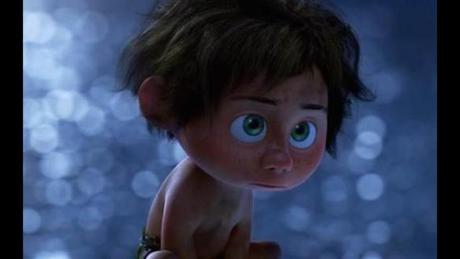 I just saw a pre-release screening of Pixar’s THE GOOD DINOSAUR that opens this week. The film took a long convoluted path since 2013 that finally ended with the studio allowing it to see the light of day. The film screens along with a pretty spectacular new Pixar 3D-Short, “SANJAY’S SUPER TEAM, created by longtime Pixar artist Sanjay Patel who makes his directorial debut with this “semi” autobiographical film of an Indian-American boy fantasizing about the similarities between his favorite TV superheroes and his father’s Hindu gods.
I just saw a pre-release screening of Pixar’s THE GOOD DINOSAUR that opens this week. The film took a long convoluted path since 2013 that finally ended with the studio allowing it to see the light of day. The film screens along with a pretty spectacular new Pixar 3D-Short, “SANJAY’S SUPER TEAM, created by longtime Pixar artist Sanjay Patel who makes his directorial debut with this “semi” autobiographical film of an Indian-American boy fantasizing about the similarities between his favorite TV superheroes and his father’s Hindu gods.
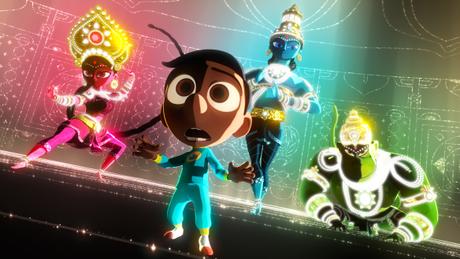
The characters and the plot-line in the The Good Dinosaur are quite similar to those Pixar visited so many times before, and so is the formulaic “find your courage” plot line. It simply retreads a lot of well-worn narrative and thematic ground in that respect. The real story about THE GOOD DINOSAUR is the fact that Pixar broke new computational ground in the re-creation of some truly amazing (and real) landscape imagery never before seen in such resolution, clarity and authenticity. A lot to write about here. But first a little bit about the film itself.
One of the biggest surprises for me about The Good Dinosaur is that it is actually a Western. It begins with a near apocalypse 65 million years ago and an asteroid racing toward Earth. And while that’s around the time, that dinosaurs became extinct, the film hypothesizes a story with alternate-timeline premise.
What if the asteroid that killed off the dinosaurs had missed the Earth? What if they had zipped right past the planet, creating a false alarm instead of an extinction level event? “What if the dinosaurs didn’t get wiped out with a meteor?” And, millions of years later, primitive humans and dinosaurs coexisted?
The Good Dinosaur presents a world where people and dinosaurs coexist, but also where the latter has become the dominant intelligent life-form. We see dinosaurs and other talking animals interacting with a feral human, and the film implies that absent the pesky meteor dinosaurs would have perhaps evolved enough to engage in agriculture. While humans scamper around on all fours, their language a primitive series of grunts, the dinos speak impeccable English, wield tools, and tend to crops.
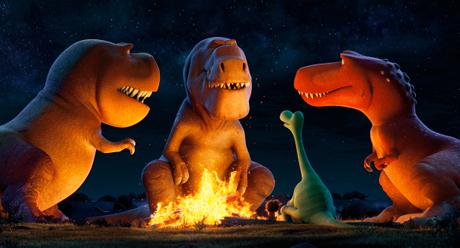
Our hero is a young Apatosaurus named Arlo (voiced by Raymond Ochoa), runt of his litter and the underachiever of his folksy farm clan. Arlo wants to “earn his mark,” to meet the expectations of his patient Poppa (Jeffrey Wright), but he can’t seem to overcome his anxiety. Thankfully, there’s nothing like a little adventure—coupled with some parental loss, a signature of Pixar’s parent company since Bambi—to instill courage in a plucky talking animal. Swept up in a rapid river and deposited miles from his home, Arlo has a dangerous voyage ahead of him. Separated from his family as they struggle to bring in the harvest (winter is coming!), Arlo finds himself alone in the wild until Spot becomes his protector and friend as they try to make their way back to Arlo’s family. Arlo will need to overcome his fears if he’s to make it home. His only steady companion: a feral human child whom he names Spot (voiced by Jack Bright, who only grunts and howls but never actually speaks words). Spot becomes his protector and friend as they try to make their way back to Arlo’s family. Arlo will need to overcome his fears if he’s to make it home.
While they start off more as adversaries (at least Arlo has a very specific reason to be angry with Spot), the two eventually become best friends as they traverse the unforgiving and often terrifying wilderness of prehistoric America. Along the way, the duo encounter religious zealot search-and-rescue pterodactyls, T-Rex cowboys, and raptors who rustle the T-Rexes’ herd of primeval longhorns. Mother Nature is also as much of an enemy here as any of the bad dinosaurs.
Spot is alone in the world, but he’s fearless and a survivor, qualities that inspire Arlo. Their bond is the best part of the film, and, with his dog-like antics, Spot steals every scene he’s in. It’s adorable and hilarious. You believe in the bond between these two, and the movie’s final moments will generate enough feels to make even the most stoic adult choke up.
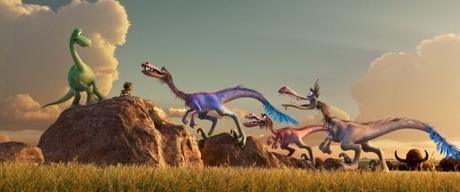
There are moments where the film can be genuinely terrifying — enough so that it may be too extreme for very little kids — with death always right around the corner. The Good Dinosaur certainly doesn’t shy away from the ever-present mortal dangers of prehistoric times with more than a few deaths (some played for laughs, others not) occurring along the way. To say more in this particular case would be to spoil things.
PIXAR’S ANIMATION TECHNOLOGY BREAKS NEW GROUND
On a technical level, The Good Dinosaur is gorgeous-looking, especially its photo-realistic imagery. Never before have water and landscapes looked so real in an animated movie.
This is a visually dazzling animated feature, with photo-realistic backgrounds effortlessly merging with somewhat more conventionally cartoonish animal characters.
Perhaps more than ever before, the animators do the heavy lifting: Every detail, from the gentle bob of a beast’s breathing to the fluid shifts of Spot’s facial expressions, has been lovingly rendered. And that’s to say nothing of the few set pieces, the most striking of which finds the fins of psychotic pterodactyls—the movie’s villainous flock—ominously dipping down out of a cluster of storm clouds, as though the sky itself was shark-infested waters.. The film is at once an enormously sophisticated visual achievement—just look at the way water ripples, the way light bounces, the shots of raindrops bouncing off leaves and clouds curling around rocky ridges here that look like real-world documentary footage. There is great beauty in every frame. While the realism allows Pixar’s artists to flex their graphical muscles in a very different way to, say, the fantastical landscapes of Inside Out, it’s also vital in cultivating the palpable sense of danger that pervades the film.
The film’s stunning locations set in Jackson Valley, the Grand Tetons & Yellowstone were created using terrain mapping technology to capture the actual geometry of several areas found in the American wilderness. As the camera pulls back further and further, our heroes become tiny specs on an enormous canvas.
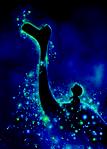
Sohn and his Director of Photography, Sharon Calahan, felt that realism would really make the characters, Arlo specifically, pop off the background. To help achieve the stunning backgrounds, Director Sohn and his team downloaded United States Geological Survey satellite photos of 65,000 square miles of the northwest, along with their topographical data.
When inputted into their computers, this gave them a 3D environment that could look out over 50 miles into the distance. The United States Geological Survey has satellite photos of all of North America along with typographical data for the height. To accomplish this near-impossible task, the set team used actual USGS data of the northwest United States to create the sets in the film.

They downloaded the terrain for Wyoming, and using the Survey’s height data and satellite images from Google Earth, they were able to bring Arlo into the landscape they had just seen. The geographical data povided a foundation the team could then build on, first with vegetation, dirt and water. It would take time to texture and populate the environment with vegetation, but the result was a lot of bang for very little buck.
They even used that data to conduct digital virtual location scouts — Pete Sohn would “visit” the locations using the virtual topographical locations created from the data and chose the locations needed for each sequence of the film. 64,600 square miles of North America were downloaded and adapted to help tell Arlo’s story. The river that takes Arlo away from his home was modeled after the Salmon River in Idaho. The desert where Arlo meets the T-rexs was modeled off of Zion National Park.
As a test, Pixar’s set team downloaded the information and took a famous Ansel Adams photo and applied the data to where the photographer would have taken the image. The result was miles and miles of 3D geographic environment. They kept the scale of the environment, but they chose different types of trees and such to suit the scene. They would also alter the data to fit their story, turning real-life locations into fictional ones.
While all this data looks beautiful (and it really does), it also took up a lot of space and time. The landscapes gobbled up 300TB of server space, 10 times the entirety of Monsters University. This is on top of the over 900 visual effects shots (which include the movements of the river, rain, smoke and clouds), twice as many as have ever been used in a Pixar movie. Just one sequence of Arlo getting swept away by a river has more data than all of Cars 2.
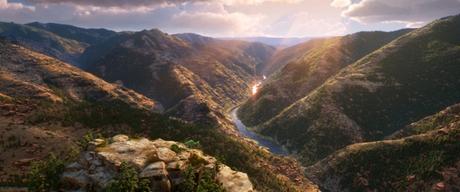
To achieve this realism effect, the Pixar team ALSO spent time in the American Northwest, immersing themselves in landscapes they wanted to recreate in Arlo’s epic journey. Director Peter Sohn and his team traveled to Jackson Hole, Wyoming, and Juntura, Oregon and southern Montana. “The area has a fantastic variety of landscapes, ranging from the Jackson Valley and the Tetons to the amazing geysers and waterfalls in Yellowstone,” said production designer Harley Jessup. “We studied the grasslands of Montana and the Red Desert, then incorporated all of it in Arlo’s journey.”
CREATING THE REALISTIC PHYSICAL BEHAVIOR OF WATERSCAPES
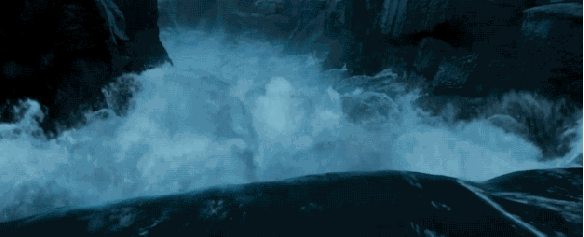
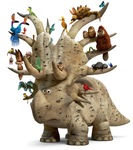
Pixar has also updated the technology used to create clouds in the film, ditching the ‘sky matte’ paintings that are traditionally used in animated films in favour of realistic digital clouds made of millions of particles – this volume of ‘thinking particles’ is particularly useful for a scene in which Arlo tosses Spot up through the clouds while running along the ridge of a mountain. They wanted to create 100% volumetric clouds or the first time. Usually Pixar just paints clouds into sets, but by creating a new cloud library, Pixar would be able to light them and insert them in many scenes. This was particularly important for stormy scenes. From the rapid river that sweeps Arlo away to the towering mountains he must learn to climb, much of the set of “The Good Dinosaur” looks so real it feels more like a photograph than animation. There are shots of raindrops bouncing off leaves and clouds curling around rocky ridges here that look like real-world documentary footage.
One of the greatest challenges for the team was a river sequence in which Arlo is swept away. The film features more than 125 shots of the water alone, more shots of water than in any other Pixar film. To achieve this, the effects team broke down the river into different pieces, and then repeated those pieces. While on these travels, the team lived the fantasy they were trying to create. They rode boats down rapid, winding rivers and went on a horse riding expedition. During their boat ride, they lost the GoPro camera that was capturing their journey. Luckily their guide later retrieved it, and the team was able to use the solo footage of the river.
SANJAY’S SUPER TEAMSanjay Patel’s Sanjay’s Super Team short cartoon that precedes this film is pretty spectacular. Longtime Pixar artist Sanjay Patel makes his directorial debut with this “semi” autobiographical film and was partnered with Pixar producer Nicole Paradis Grindle.A little boy races to the TV for cartoons only to be called over by his father for Hindu meditation. While it’s a big deal that the movie represents Pixar’s move to show more diversity in their storytelling, it also happens that Sanjay’s Super Team is a visually interesting, exciting, and heartwarming film that will likely win audiences over from the minute Sanjay bounces on-screen with his action figure.The “mostly true story” of an Indian-American boy fantasizing about the similarities between his favorite TV superheroes and his father’s Hindu gods is helmed by first-time director Sanjay Patel, a Pixar animator since A Bug’s Life, it’s a personal story about how he related to his father and his family’s culture as a child. It’s a fast-paced, dynamic superhero throwdown, full of Tron-worthy, bright, glowing colors and a tremendously effective sound design. It’s sweet and intense.According to Sanjay Patel: Personally, I’ve done a lot of research and study of Hindu culture and find the myths to be very inspiring and appreciate how sacred they are to my dad and his friends. So going in, I knew exactly what we had on our hands. So each deity was carefully constructed and we paid close attention to the details, to make sure they were respectful. But it was also fun to think that we were introducing some people to them and showing why they are significant and how they are different. Why Vishnu is blue but Hanuman is green? And we made and thought about all those specific choices, because we knew right away that if we didn’t, we would upset some people. We just wanted to be faithful to the mythology. But from there, we wanted to form some connections which might have gone overlooked. In India, these classical myths are performed all the time, often in theater or dance. So we drew upon those traditions. We brought in an expert who had studied traditional dance in India, and taught our animators how to be specific in the deities’ movement, because we don’t use language in the film. So each deity was assigned a specific dance tradition. So we tried to give each layer an interesting way of introducing this culture to people who may have no knowledge going into the theater.With every new Pixar movie not only comes the excitement of new family movie, but the appetizer of a new short. With the release this week of The Good Dinosaur comes one of the best shorts in recent years: Sanjay’s Super Team.
A little boy races to the TV for cartoons only to be called over by his father for Hindu meditation. Yes, it’s a big deal that the movie is Pixar’s move to showing more diversity in their storytelling, but it also happens to be a visually interesting, exciting, and heartwarming films that will likely win audiences over from the minute Sanjay bounces on-screen with his action figure. Longtime Pixar artist Sanjay Patel is making his directorial debut with this “semi” autobiographical film and was partnered with Pixar producer Nicole Paradis Grindle.
AN INTERVIEW: Sanjay’s Super Team Pixar Team: Sanjay Patel and Nicole Paradis Grindle
Lesley Coffin: You put in right at the beginning that the movie is “based” on a true story, so I’m just curious what part of the story was inspired by your real life?
Sanjay Patel: The initial pitch was actually something completely different, and didn’t really have anything to do with family. It was just about a kid who wasn’t appreciating his culture and absorbed in comic books.
Nicole Paradis Grindle: A generic kid from India right?
Patel: Yeah, and the premise was just about a kid appreciating his culture. And as I was telling the story, I showed this drawing I had, which illustrated the way I grew up with my dad. And I told John Lasseter a little bit about how I grew up, and that every morning, my dad would get up in the morning and worship his gods, while I would worship mine on TV. And I had this one drawing that really illustrated that, and straight away, John said he loved the idea about a movie about a kid not appreciating his culture, but he also really loved the idea that through appreciating your culture, you can build a connection with your father. And that was absolutely true of my own story and isn’t something we had to manufacture for this film. It took be 30 years to get here, but it is definitely based on a true story.
TMS: I know you’ve both worked at Pixar for a while, but this being your first time directing, how did you partner up and create the team for this film?
Grindle: They just kind of put us together because I was available. Perhaps it was kind of by design but no one told us that or gave us a reason why. But it has turned into a great partnership. We really get along well and I was very passionate about the story and bringing his vision to the screen. It’s a great story and I am personally someone who gets excited about seeing new and fresh voices on screen, and that includes having more ethnicity and women in leadership roles. So this project certainly resonated and we had a good relationship right away.
TMS: Had you ever worked on a film together?
Grindle: We have both worked on the same films, but in the past, Sanjay has always worked on animation or was part of the story team, and I was always in a different department. So this was our first time really working together.
Patel: But I’ve seen all of Nicole’s work growing up. I was obsessed with the shows she worked on at Liquid Television, like Æon Flux. And of course Roger Rabbit, which is one of the seminal movies of my childhood.
Grindle: I can take no credit for that movie. The production assistant takes no credit for that film’s success! I never thought I would work in animation until I did that movie, and then I just fell in love with the world of animation and all the people that work in that world.
TMS: Father and son are so instantly endearing and sweet, because they aren’t hyper-realistic human characters, but they also have some very realistic features, like the design of their eyes. How did you decide on the character’s design and style?
Patel: There was a lot going on when we were thinking about and designing those characters. One of the big things were concerned about was how to link the designs of essentially the two worlds together, and show a connection between father and son with their features. But we also wanted to create a design aesthetic which felt universal for all the characters. Initially we designed father and son in isolation from the deities, but then John Lasseter came in and suggested finding something to unify all the characters. So our art director looked at classical Indian sculptures and saw that many have these beautiful eyebrows and noses which give the eyes an almond shape. So we used that to unify the characters.
TMS: Whenever doing a film that deals with religion, you have to consider how respectful you are compared to how much freedom you have, but with this film you also had to make the film both playful and informative for kids. How did you determine the approach you would take on this film?
Patel: Personally, I’ve done a lot of research and study of Hindu culture and find the myths to be very inspiring and appreciate how sacred they are to my dad and his friends. So going in, I knew exactly what we had on our hands. So each deity was carefully constructed and we paid close attention to the details, to make sure they were respectful. But it was also fun to think that we were introducing some people to them and showing why they are significant and how they are different. Why Vishnu is blue but Hanuman is green? And we made and thought about all those specific choices, because we knew right away that if we didn’t, we would upset some people. We just wanted to be faithful to the mythology. But from there, we wanted to form some connections which might have gone overlooked. In India, these classical myths are performed all the time, often in theater or dance. So we drew upon those traditions. We brought in an expert who had studied traditional dance in India, and taught our animators how to be specific in the deities’ movement, because we don’t use language in the film. So each deity was assigned a specific dance tradition. So we tried to give each layer an interesting way of introducing this culture to people who may have no knowledge going into the theater.
Grindle: But in a respectful way. We were so aware of those concerns, and didn’t want to do anything which might make those deities look too cartoonish or too much like the superheroes on Sanjay’s TV. That was parallel we drew, but we don’t want anyone to say they are just like superheroes. These are deities and we want to honor them.
TMS: The deities’ have that stream of light which makes the action sequences feel so unique and graceful in a way we haven’t seen before. Was that part of the reason you chose to look at dance traditions?
Grindle: We were talking about incorporating something which made things feel almost cosmic and infinite. And Sanjay is a big fan of Anime so he drew from those influences, but we also talked about everything from the Arora Borealis to an image from 2001: A Space Odyssey. And with all that brainstorming with our team, we found a way to turn that old, gray temple into something where the walls seem to melt away and turns into this cosmic space. We wanted to experience the transformation from something feeling enclosed and dark to something feeling light and beautiful. Really create a sense of the celestial realm on screen.
TMS: How familiar were you with Hindu culture?
Grindle: Not very much at all. I think I came at this from a very typical white, European background. I knew something of it, but very little. I’ve learned so much doing this film and found that part of it to be really enjoyable. I found there is so much depth that I never knew about before, and just hope other people from a similar background are inspired by this film to learn more. I’m sure a lot of people will go in saying “I don’t know about these deities” but want to learn about them. And they are just the tip of the iceberg.
TMS: You use the superhero connection in the movie as the little boy’s entry point into understanding what his dad is talking about. But when you were growing up, did you have any kid friendly things to teach you and get you excited about the Hindu religion?
Patel: I was born in the UK but raised in LA, so I kind of had three level of removed. And the community in LA was still pretty new. There wasn’t even temple nearby. But in the 70s, there were some comic books published called Amar Chitra Katha which means Immortal Stories or Golden Stories. But they were kind of frozen relics from the early 70s, but just kept in circulation because there wasn’t anything else out there. I mean, they aren’t X-Men comics, so I was sort of like “boring.” But it was crazy when I finally got a job at Pixar, the church of modern day storytelling, and felt moved enough by these myths to want to tell them in a way so a kind like me in a culture like this could appreciate them. That was a huge motivator for me, because those comic books I had as a kid were terrible and did not get me interested. I can appreciate them now as an adult, but certainly not a kid.
Grindle: But most religions have those entry points for kids or kid friendly version of the stories, but it doesn’t sound like that exists in Hinduism.
